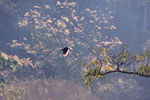FEATURED ARTICLES [Latest news updates]
Can carbon credits from REDD compete with palm oil?

|
|
(03/30/2009) Reducing emissions from deforestation and degradation (REDD) is increasingly seen as a compelling way to conserve tropical forests while simultaneously helping mitigate climate change, preserving biodiversity, and providing sustainable livelihoods for rural people. But to become a reality REDD still faces a number of challenges, not least of which is economic competition from other forms of land use. In Indonesia and Malaysia, the biggest competitor is likely oil palm, which is presently one of the most profitable forms of land use. Oil palm is also spreading to other tropical forest areas including the Brazilian Amazon.
[REDD | Rainforests | Featured | Palm oil]
Costa Rica pictures updated
(03/27/2009) Earlier this month I was in Costa Rica. These are some highlights from the latest trip.
[Costa Rice pictures]
Satellites and Google Earth prove potent conservation tool [Yale e360]
(03/26/2009) Armed with detailed images from space and remote sensing data, scientists, environmentalists, and armchair conservationists are now tracking threats to the planet and communicating them vividly to the public. Posted on the e360, an online publication from the Yale School of Forestry & Environmental Studies
[Yale e360]
Will palm oil drive deforestation in the Amazon?
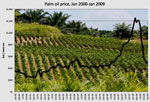
|
|
(03/23/2009) Already a significant driver of tropical forest conversion across southeast Asia, oil palm expansion could emerge as threat to the Amazon rainforest due to a proposed change in Brazil's forest law, new infrastructure, and the influence of foreign companies in the region, according to researchers writing in the open-access journal Tropical Conservation Science. William F. Laurance, a senior scientist at the Smithsonian Tropical Research Institute (STRI) in Panama City, Panama, and Rhett A. Butler, founder of Mongabay.com, warn that oil palm expansion in the Brazilian Amazon is likely to occur at the expense of natural forest as a result of a proposed revision to the forest code which requires land owners to retain 80 percent forest on lands in the Amazon. The new law would allow up to 30 percent of this reserve to consist of oil palm.
[Tropical Conservation Science | Amazon | Palm oil]
New issue of Tropical Conservation Science
(03/23/2009) The latest issue of Tropical Conservation Science, mongabay.com's open-access, peer-reviewed academic journal, is now online. It includes papers on the potential expansion of industrial oil palm plantations in the Amazon, harvesting of the Andean Tree Iguana in Bolivia, bushmeat hunting in Tanzania, frog hunting in Madagascar, the implications of traditional use of plants on conservation, analysis of the conservation impact of a territorial dispute between Belize and Guatemala, an examination of genetic diversity of a group of legumes in southeast Asia, and a discussion of the merits of using butterflies as a proxy for rapidly assessing biodiversity.
[Tropical Conservation Science]
Norway emerges as champion of rainforest conservation

|
|
(03/19/2009) While citizens in western countries have long paid lip service to saving rainforests, Norway has quietly emerged as the largest and most important international force in tropical forest conservation. The small Scandinavian country has committed 3 billion krone ($440 million) a year to the effort, a figure vastly greater than the $100M pledged — but never fully contributed — by the United States under the Tropical Forest Conservation Act (TFCA). Norway now hopes it can help push to include forest conservation in the successor to the Kyoto Protocol by providing funding and fostering cooperation among international actors like the UN and World Bank, as well as developing countries, to fund the creation of an international architecture which makes it possible to incorporate deforestation and degradation into a post-2012 climate regime.
[REDD | Rainforests | Featured | Saving rainforests]
Political turmoil in Madagascar threatens lemurs, parks

|
|
(03/19/2009) Political turmoil in Madagascar has wrecked the country's emerging ecotourism industry and is now threatening to undo decades of conservation work. Conservation in Madagascar is highly dependent on income from tourism. Half of park entrance fees are returned to communities living in and around protected areas. Without this source of income, locals in some areas may turn to conservation areas for timber, fuelwood, agricultural land, and wildlife as food and for export.
[Madagascar | Conservation | Lemurs]
37,000 sq km of Amazon rainforest destroyed or damaged in 2008

|
Uncovering the mysteries of the imperiled giraffe, an interview with Julian Fennessy

|
|
(03/09/2009) Dr. Julian Fennessy probably knows the giraffe better than anyone. Trekking across savannah, forest, and the deserts of Africa, Fennessy is collecting genetic samples of distinct giraffe populations and overturning common wisdom regarding their taxonomies. It had long been accepted knowledge that the giraffe was made up of one species and several subspecies, however with Fennessy's work it now appears that several of the subspecies may in fact be distinct species. Such discoveries could have large conservation impacts, since conservation funds and efforts are largely devoted to species. The giraffe has suffered significant declines in the past decade with the total population dropping some 30 percent across Africa.
[Africa | Interviews | Wildlife]
37,000 sq km of Amazon rainforest destroyed or damaged in 2008

|
|
(03/19/2009) Logging and fires damaged nearly 25,000 square kilometers (9,650 square miles) of Amazon rainforest in the August 2007-July 2008 period, an increase of 67 percent over the prior year period, according to a new mapping system developed by Brazil's National Institute for Space Research (INPE). The damage comes on top of the nearly 12,000 sq km (4,600 sq mi) of rainforest that was cleared during the year.
[Amazon | Brazil | Remote sensing]
Uncovering the mysteries of the imperiled giraffe, an interview with Julian Fennessy

|
|
(03/09/2009) Dr. Julian Fennessy probably knows the giraffe better than anyone. Trekking across savannah, forest, and the deserts of Africa, Fennessy is collecting genetic samples of distinct giraffe populations and overturning common wisdom regarding their taxonomies. It had long been accepted knowledge that the giraffe was made up of one species and several subspecies, however with Fennessy's work it now appears that several of the subspecies may in fact be distinct species. Such discoveries could have large conservation impacts, since conservation funds and efforts are largely devoted to species. The giraffe has suffered significant declines in the past decade with the total population dropping some 30 percent across Africa.
[Africa | Interviews | Wildlife]
Photos from Khao Yai, Thailand
(03/07/2009) I spent most of January in Laos and Thailand looking at the wildlife trade, conservation, and other issues. Here are some pictures from Khao Yai National Park in Thailand.
[Thailand pictures]
Drought threatens the Amazon rainforest as a carbon sink
(03/05/2009) Drought in the Amazon is imperiling the rainforest ecosystem and global climate, reports new research published in Science. Analyzing the impact of the severe Amazon drought of 2005, a team of 68 researchers across 13 countries found evidence that rainfall-starved tropical forests lose massive amounts of carbon due to reduced plant growth and dying trees. The 2005 drought — triggered by warming in the tropical North Atlantic rather than el Niño — resulted in a net flux of 5 billion tons of carbon dioxide (CO2) into the atmosphere — more than the combined annual emissions of Japan and Europe — relative to normal years when the Amazon is a net sink for 2 billion tons of CO2.
[Amazon | Rainforests | Drought]
Economic crisis hits conservation but may offer opportunities, says TNC president

|
|
(03/03/2009) In 2008 The Nature Conservancy (TNC) surprised the conservation world when it selected Mark Tercek, an investment banker from Goldman Sachs, as its new president and CEO. But for people who have worked with Tercek, the move made strategic sense – Tercek was a leading figure in the Goldman's effort to improve its environmental record. In 2005 Tercek was appointed to head up the firm's Environmental Strategy Group, which develops and implements its environmental policy, and its Center for Environmental Markets, an initiative that examines market-based solutions to environmental challenges. In that role Tercek worked with pioneers in ecosystem services science, including Gretchen Daily of Stanford University; John Holdren, the former director of the Woods Hole Research Center and currently President Obama's chief scientific adviser; and Peter Kareiva, chief scientist at TNC.
[Interviews | Ecosystem services | Conservation]
Cameroon may liquid rainforest reserve if conservationists don't step forward
(03/02/2009) The opportunity to conserve a one million hectare tract rainforest in Cameroon is fast dwindling due financial pressures in the Central African country, reports a bulletin from the Ngoyla Mintom Foundation. In 2002 the government of Cameroon suspended logging rights and extended an offer to protect Ngoyla Mintom — a forest reserve that houses 4,000 lowland gorillas, 1,500 endangered chimpanzees, 3,000 forest elephants and an important population of vulnerable Mandrills — provided someone step forward to pay for it. To date there have been no takers. Now facing a mounting economic crisis, the government of Cameroon says it will soon concession Ngoyla Mintom for logging.
[Cameroon | Logging | Avoided deforestation]
Massive population of rare Irrawaddy dolphins discovered in Bangladesh

|
|
(03/31/2009) The Wildlife Conservation Society (WCS) has discovered an unknown population of the rare Irrawaddy dolphin in Bangladesh numbering 6,000 individuals. The dolphins were found in the freshwater areas of the Sundarbans mangrove forest. Prior to this discovery, the largest known populations of Irrawaddy dolphins numbered only in the hundreds.
[Happy-upbeat environmental | Cetaceans | Endangered species]
Development of Google Earth a watershed moment for the environment
(03/31/2009) Satellites have long been used to detect and monitor environmental change, but capabilities have vastly improved since the early 1970s when Landsat images were first revealed to the public. Today Google Earth has democratized the availability of satellite imagery, putting high resolution images of the planet within reach of anyone with access to the Internet. In the process, Google Earth has emerged as potent tool for conservation, allowing scientists, activists, and even the general public to create compelling presentations that reach and engage the masses. One of the more prolific developers of Google Earth conservation applications is David Tryse. Neither a scientist nor a formal conservationist, Tryse's concern for the welfare of the planet led him develop a KML for the Zoological Society of London's EDGE of Existence program, an initiative to promote awareness of and generating conservation funding for 100 of the world's rarest species. The KML allows people to surf the planet to see photos of endangered species, information about their habitat, and the threats they face. Tryse has since developed a deforestation tracking application, a KML that highlights hydroelectric threats to Borneo’s rivers, and oil spills and is working on a new tool that will make it even easier for people to create visualizations on Google Earth. Tryse believes the development of Google Earth is a watershed moment for conservation and the environmental movement.
[Remote sensing | Google Earth]
Deforestation maps for Sumatra now available on Google Earth
(03/31/2009) Despite many years of research in conservation biology, precise maps of tropical deforestation that document the global spatial extent of tropical forests destruction are generally not available outside of the scientific community, says David Gaveau a researcher from Durrell Institute of Conservation and Ecology (DICE) points out. For nearly seven years, Gaveau has been documenting forest destruction on the entire island of Sumatra since early 1970s using satellite technology, and he has found the way to make his full-resolution maps and scientific results public using Google Earth.
[Sumatra | Remote sensing | Google Earth | Deforestation]
Hopeful conservation news emerges out of Madagascar political crisis
(03/31/2009) Some hopeful conservation news has finally emerged out of the political crisis in Madagascar, report local sources. Wednesday representatives from several NGOs active in conservation in Madagascar met with a minister from island nation's new government. The minister said his top priority was putting an end to illegal logging that emerged when rangers abandoned their posts and armed gangs moved into protected areas in the wake of the political crisis.
[Madagascar]
Two Sumatran elephants shot dead in Indonesian park
(03/31/2009) As reported by the Associated Press, two 20-year-old female Sumatran elephants were found on March 24th dead in the forests of Kerinci National Park due to gunshots in the head. The females had been partners with local rangers, who rode them to patrol the park to keep out illegal loggers.
[Sumatra | Elephants | Poaching]
Have Australian cane toads finally met their match?
(03/31/2009) This weekend in Queensland, Australia the government held the first 'Toad Day Out' where hundreds of locals went hunting for the invasive cane toad, catching an estimated 10,000 toads to be euthanized. At the same time, researchers announced in the journal Functional Ecology that they may have discovered a native Australian species that will finally rout the cane toad—and it's not man. The meat ant is a notoriously aggressive and abundant insect which is known to consume anything edible, including the scientists argue, cane toads.
[Invasive species | Australia | Amphibians]
Amazonian region likely to become savannah due to burning, deforestation
(03/31/2009) A new analysis shows that the heavily-deforested Amazonian region of Mato Grosso is particularly susceptible to 'savannization' due to repeated burning that has likely depleted the region's soils of precious nutrients. According to the study, published in the Journal of Geophyscial Research, savannization, or the process of tropical ecosystems shifting to savannah, is likely in northern Mato Grosso even if no further deforestation occurs.
[Amazon | Deforestation | Drought]
Carbon credits from forest conservation would crash carbon market, says Greenpeace

|
|
(03/30/2009) Inclusion of forest conservation in a market-based mechanism for reducing greenhouse gas emissions would crash carbon prices by swamping the market with cheap credits, claims a new report from Greenpeace. The environmental group said low carbon prices would "derail global efforts to tackle global warming" and cause "developing countries losing out on billions of dollars a year for investment in clean energy technologies".
[Avoided deforestation | Deforestation | REDD]
Conservation groups condemn 'open and organized plundering' of Madagascar's natural resources

|
|
(03/30/2009) Eleven conservation organizations—including WWF, CI, and WCS—have banded together to condemn logging in Madagascar's world renowned parks during a time of political crisis. Taking advantage of the turmoil after interim president Andry Rajoelina took control of the country in a bloodless coup from former president Marc Ravalomanana on March 17th, pristine forests have been plundered for valuable wood, wildlife trafficking has increased, and illegal mining operations have begun say the conservation organizations.
[Madagascar | Logging]
Crabs feel pain, and remember it too
(03/30/2009) Research from Queen's University Belfast has raised new issues about the culinary arts. Long-thought by cooks and diners to be insensible to pain, a new study published in the journal Animal Behavior shows that crabs not only feel pain but remember it well-enough after the sensation has passed to affect their future decisions. According to Dr. Bob Elwood, who headed up the research, the study should bring about changes in how crustaceans like crabs are treated by the fishing and food industries.
[Animal behavior]
Plant communities changing across the globe, says scientist Sasha Wright

|
|
(03/30/2009) Having studied plant communities across three continent and within widely varied ecosystems—lowland tropics, deciduous forests, grasslands, and enclosed ecosystems on hill-tops—graduate student Sasha Wright has gained a unique understanding of shifts in plant communities worldwide as they respond to pressures from land use and global climate change. "Plant communities are certainly changing," Wright told Mongabay.com in a March 2009 interview. "These changes are undoubtedly affected by an increased occurrence of extreme weather events, temperature fluctuations, atmospheric CO2 concentrations, human land use, and in some cases urbanization of populations."
[Botany | Interviews with young scientists | Interviews | Featured]
Flu epidemic killing bonobos in Congo sanctuary

|
|
(03/30/2009) Six bonobos, a species of chimpanzee, have died from a flu epidemic in a month at the Lola Ya Bonobo in the Democratic Republic of Congo (DRC). Ten more have contracted the flu. “There is no fever. Antibiotics don’t do anything. The bonobos have severe respiratory infections and then they can’t breath for 3 days then they die,” writes a staff member on the sanctuary's blog through the conservation organization WildlifeDirect. The staff of Lola Ya Bonobo have sent out a plea for help and donations, as the flu continues to sweep through their center.
[Chimps | Primates | Congo]
Advancements in satellite technology will help scientists and policy makers map and monitor forest carbon

|
|
(03/30/2009) Given that deforestation accounts for nearly one fifth of anthropogenic greenhouse gas emissions, reducing forest clearing and degradation is increasingly seen as an critical component to any framework addressing climate change. By some estimates, a mechanism that compensates countries for reducing emissions from deforestation and forest degradation (REDD) could funnel billions of dollars per year towards forest conservation. However the effectiveness of such a mechanism will hinge on the quality of data. Effective mapping and monitoring of forest carbon stores is absolutely key to any mechanism that compensates countries for reducing emissions from deforestation and forest degradation.
[Remote sensing | Satellite imagery | REDD]
More than 300 gorillas butchered each year in the Republic of Congo
(03/27/2009) During 2008 and early 2009, Endangered Species International (ESI) conducted monitoring activities using undercover methods at key markets in the city of Pointe Noire, the second biggest city in Congo. Findings reveal that 95 percent of the illegal bushmeat sold originates from the Kouilou region about 100-150 km northwest to Pointe Noire where primary and unprotected rainforest still remains. The Kouilou region is one the last reservoirs of biodiversity and endangered animals in the area.
[Gorillas | Congo]
After seizure, gorilla receives MRI scan free of charge
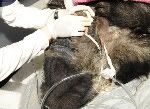
|
|
(03/26/2009) The Wildlife Conservation Society announced today that a 42-year-old western lowland gorilla named Fubo received a free MRI scan after suffering a seizure at his home in the Bronx Zoo's Congo Gorilla Forest exhibit. The MRI was provided by The Brain Tumor Foundation, which sent a 48-foot-long moveable MRI facility to the zoo. Overseen by vets, zookeepers, and various medical personnel, the scan revealed that Fubo had a lesion on his left temporal lobe of his brain.
[Gorillas | Ex-situ conservation]
New technology allows researchers to study mass migrations of fish
(03/26/2009) Employing a new technology, MIT engineers have studied the origins of a mass gathering of hundreds of millions of fish and their subsequent migration. This is the first time a mass migration of animals has been studied from beginning to end, according to their paper published in Science. Until now biologists have depended on theory rather than data from the field, employing computer simulations and experiments in the lab.
[Fish | Oceans | Animal behavior]
Greenpeace accuses Sinar Mas corporation of violence toward its protestors
(03/26/2009) In a press release issued by Greenpeace the organization states that Sinar Mas corporation security guards “brutally kicked and punched” peaceful protestors in Jakarta, Indonesia on March 19th. Greenpeace activists had chained themselves to the entrance of Sinar Mas headquarters and hung a banner labeling the corporation a 'Forest and Climate Criminal'.
[Palm oil | Activism | Indonesia]
Harbor seals return to New York

|
|
(03/26/2009) More than a hundred years passed, and the Hudson River and Atlantic Ocean estuary was cleaned up—enough to support the comeback of the harbor seal.
In spring of 2006, kayakers and recreational boaters who frequent the waters around the Verrazano Bridge, took note of what appeared to be marine mammals that had not been there before. Were there harbor seals, again in this urban estuary? The boaters notified the Kingsborough Community College for Maritime Studies and the New York Aquarium, who teamed up to investigate, and thus, began the first annual harbor seal survey.
[Marine mammals | Wildlife]
Malaysian palm oil targets the Amazon
(03/25/2009) Malaysia's Land Development Authority FELDA will soon break ground on a joint venture with a Brazilian firm to establish 30,000-100,000 hectares (75,000 - 250,000 acres) of oil palm plantations in the heart of the Amazon rainforest, reports the Malaysian Star.
[Amazon | Palm oil]
Hawaii continues to stand-by as sheep destroy critically-endangered palila bird's habitat
(03/25/2009) The environmental legal organization, Earthjustice, has filed legal papers against the Hawaii State Department of Land and Natural Resources for failing to keep feral sheep and goats out of the critically-endangered palila bird's last habitat. According to Earthjustice, the court has already issued three orders beginning in 1979 that found the state of Hawaii in violation of the Endangered Species Act by not protecting the palila bird from the destructive feeding practices of sheep and goats.
[Birds | Endangered species]
Undocumented species discovered in Papua New Guinea

|
|
(03/25/2009) Colorful jumping spiders, a tiny frog with a "ringing song" and a striped gecko are among more than 50 previously unknown species discovered during a recent survey in the remote highlands of Papua New Guinea. More than 600 species were documented during the 2008 expedition, which was led by Conservation International (CI) under its Rapid Assessment Program (RAP).
[New Guinea | Species discovery]
Fisherman killed by two Komodo dragons
(03/24/2009) Mohamad Anwar, 32, was killed by two Komodo dragons after trespassing in Komodo National Park in order to gather fruit according to CNN.
[Herps | Indonesia]
Fire in Kenya threatens some of the world's most beloved parks
(03/24/2009) Started by arsonists, fires have swept through Kenya's Great Rift valley, home of some of the world's most treasured parks and ten million Kenyans already suffering from long-term drought.
[Fires | Kenya | Parks]
Twenty years on, some birds still haven't recovered from Exxon Valdez oil spill
(03/24/2009) Twenty years ago today—at 12:04 AM on March 24th, 1989—the Exxon Valdez tanker struck Bligh reef in Prince William Sound causing 10.8 million gallons of crude oil to spill into the sea. The spill decimated the ecosystem and wildlife for 11,000 square miles and became one of the world's most infamous oil spills. Twenty years later, researchers say that several bird species have yet to recover from the spill.
[Pollution | Birds | Oil]
Ebay bidders to decide new shrimp's name
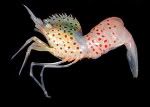
|
|
(03/24/2009) A new way to raise conservation funds has captured attention worldwide. The Australian Marine Conservation Society (AMCS) has auctioned the naming rights of a newly discovered species of shrimp on Ebay. "The shrimp is in the group or genus of shrimps known as Lebbeus, but is awaiting the addition of a unique species name," said Anna McCallum, a Melbourne scientist who discovered the new species in deep waters off the Southwest coast of Australia.
[Australia | Oceans | Conservation finance]
Ocean fertilization will not help reduce CO2 levels, suggests experiment
(03/24/2009) A controversial 'ocean fertilization' experiment suggests seeding the seas with iron to boost carbon-absorbing phytoplantkon will not sequester much carbon dioxide from the atmosphere. Some — including researchers and private companies — had hoped iron fertilization might be an easy fix for climate change.
[Oceans | Carbon sequestration]
Scramble to log Madagascar's valuable rainforest trees in midst of crisis

|
|
(03/23/2009) Armed gangs are logging rosewood and other valuable hardwoods from Marojejy and Masoala parks in Madagascar following abandonment of posts by rangers in the midst of the island nation's political crisis, reports marojejy.com and local sources. Timber poachers and other interests are now moving aggressively into protected areas to take advantage of the opportunity.
[Madagascar | Illegal logging]
REDD in Indonesia could evict forest people from their lands, warns U.N. committee
(03/23/2009) In a letter released today, the United Nations Committee on the Elimination of Racial Discrimination expressed concern that a scheme to promote forest conservation in Indonesia via the Reduced Emissions from Deforestation and Forest Degradation (REDD) mechanism could increase conflict over land if the government doles out forest-carbon concessions in the same manner that it has with logging concessions. In the worst cases, forest people could be denied access rights to their traditional territories say indigenous rights' groups.
[REDD | Indonesia]
Mama tree iguanas targeted by hunters as source of traditional medicine in Bolivia
(03/23/2009) Harvesting of a Bolivian lizard for its purported healing powers is leading to its depletion, report researchers writing in Tropical Conservation Science. Erika De la Galvez Murillo and Luis F. Pacheco of the Universidad Mayor de San Andrés found that collection of the Andean Tree Iguana or "Jararank'o" (Liolaemus signifer), a lizard found on Bolivia's dry Altiplano, for use in traditional medicine reduced population by nearly half relative to unharvested sites. They note that the species may suffer increased mortality when dens are destroyed during harvesting since mother lizards — targeted by collectors for their size — care for their young.
[Tropical Conservation Science | Herps]
Bushmeat hunting in Tanzania
(03/23/2009) Bushmeat hunting constitutes the most immediate threat to wildlife populations in the Udzungwa Mountains of the Eastern Afromontane biodiversity hotspot in Tanzania. A new study, published in Tropical Conservation Science assesses the impact of hunting by comparing densities of mammalian species between the little hunted West Kilombero Scarp Forest Reserve, the medium-hunted Udzungwa Scarp Forest Reserve and the intensively hunted New Dabaga Ulangambi Forest Reserve.
[Tropical Conservation Science | Bushmeat | Tanzania]
Frogs are an important food source for people in parts of Madagascar
(03/23/2009) With its famous diversity of frog species, Madagascar has long been targeted by smugglers for the pet trade. While this threat is relatively well understood, less known is the domestic market for edible frogs. Writing in Tropical Conservation Science, researchers from the University of Aberdeen and institutions in Madagascar provide a glimpse into this activity.
[Tropical Conservation Science | Biodiversity]
Traditional practices contribute to conservation of medicinal plants
(03/23/2009) Traditional practices contribute to conservation of medicinal plants in West Usambara Mountains, Tanzania, report Tuli S Msuya and Jafari R Kideghesho in the March issue of the open access journal Tropical Conservation Science.
[Tropical Conservation Science | Biodiversity | Medicinal plants]
Territorial disputes and conservation
(03/23/2009) Political drivers such as those related to territorial disputes between tropical countries can result in direct and indirect ramifications negatively impacting conservation of native ecosystems report Arlenie Perez, Chuang Chin-Ta and Farok Afero in the March issue of the open access journal Tropical Conservation Science.
[Tropical Conservation Science | Belize | Guatemala]
Loss of genetic diversity hurts agriculture

|
|
(03/23/2009) Agriculture has long been dependent on the ability of plant species to adapt to varying environmental conditions — without this diversity agriculture development would not have been possible. But human activities are putting this diversity at risk through habitat destruction and introduction of alien species, especially in parts of the world where such diversity is particularly critical: tropical developing countries. This threat has spurred increased efforts to find and conserve plants with special traits adapted to the marginal farming systems of tropical smallholders.
[Tropical Conservation Science | Agriculture | Biodiversity]
Assessing Tropical Butterfly Communities When Time Is Short
(03/23/2009) Butterflies can be used to quickly assess the conservation value of an area, report researchers writing in the journal Tropical Conservation Science. Timothy Bonebrake of Stanford University and Rubén Sorto of SalvaNATURA managed to sample 40-60% of the butterfly community in Playa El Icacal, El Salvador in just nine days. In the process, they identified areas in the region that hold the most conservation value.
[Tropical Conservation Science | Biodiversity]
Land rights victory for Amazon Indians in Brazil
(03/20/2009) In what is being hailed as a victory for indigenous groups in the Brazilian Amazon, Brazil's Supreme Court sided with Indians from the Raposa Serra do Sol reservation in a 30-year land dispute with large-scale farmers in the northern state of Roraima, near the border with Venezuela, reports the Associated Press.
[Amazon | Brazil | Indigenous people]
DR Congo, Indonesia, PNG, Tanzania, Vietnam win REDD funding for forest conservation
(03/20/2009) The United Nation's REDD Program has approved $18 million in support of forest conservation projects in five pilot countries: Democratic Republic of Congo, Indonesia, Papua New Guinea, Tanzania, and Viet Nam.
[REDD]
One third of US birds endangered
(03/19/2009) Ken Salazar, the nation's new Secretary of the Interior, today released the first comprehensive report on bird populations in the United States. The findings are not encouraging: nearly one third of United States' 800 bird species are endangered with even once common species showing precipitous declines. Habitat loss and invasive species are blamed as the largest contributors to bird declines.
[United States | Birds]
Protecting watersheds secures freshwater and saves billions of dollars
(03/19/2009) The World Water Forum brings together 25,000 experts this week in Istanbul, Turkey to discuss the water challenges facing a growing world. According to a compilation of case studies by the International Union for Conservation of Nature (IUCN), which is sponsoring the event, one of the simplest and least expensive ways to have ample water for a growing human population is to protect watersheds. Not only do protected watersheds provide clean and easy-access water for many of the world's largest cities, their protection also saves billions of dollars.
[Water | Ecosystem services]
When it comes to global warming Americans trust scientists most, family and friends second
(03/19/2009) A new poll released today by Yale and George Mason Universities finds that Americans trust scientists most when it comes to information on climate change. Second to scientists is family and friends, which beat out environmental organizations, religious leaders, mainstream media, and President Obama.
[Politics | Climate change]
Over 90 percent of Americans support action on climate change in midst of financial crisis
(03/19/2009) A new poll released today by Yale and George Mason Universities finds that Americans overwhelmingly—92 percent—support action to reduce global warming. However opinions vary as to how much effort should be put into reducing CO2 emissions and what actions are appropriate.
[Politics | Climate change]
Photo: critically endangered vulture saved from poisoning

|
|
(03/19/2009) Seven critically-endangered white-rumped vultures were found dead in Cambodia after feeding on the corpse of a poisoned buffalo. Two survivors however were also apart of the group. An adult and a juvenile that had fed on the poisoned buffalo were sick but alive. The pair was sent to a veterinary clinic in Phnom Penh to be cared for by staff from the Wildlife Conservation Society (WCS) and the Angkor Centre for Conservation of Biodiversity (ACCB).
[Birds | Conservation | Wildlife]
Rash of tiger attacks linked to deforestation by large paper corporation APP

|
|
(03/18/2009) The Sumatran tiger, a critically-endangered subspecies, is hanging on by a thread in its island home. Biologists estimate that at most 500 individuals remain with some estimates dropping as low as 250. Despite the animal's vulnerability, large-scale deforestation continues in its habitat mostly under the auspices of one of the world's largest paper companies, Asian Pulp and Paper (APP). Shrinking habitat and human encroachment has led to a rise in tragic tiger encounters, causing both human and feline mortalities.
[Sumatra | Deforestation | Tigers]
Smallest Andean frog discovered in cloud forests of Peru

|
|
(03/18/2009) At 3,000 meters (9,842 feet) in the Andes herpetologists were surprised to discover a frog so small it could sit on a dime with room to spare. Further study showed that this new species, named Noble's pygmy frog, is the smallest frog in the Andean mountain range.
[Amphibians | Peru | New species]
Plastic garbage accounts for one-third of leatherback sea turtle mortalities
(03/17/2009) A new study in Marine Pollution Bulletin has confirmed that the world's largest sea turtle is succumbing in startling numbers to an environmental issue that receives little attention: plastic trash in the oceans.
[Oceans | Sea turtles]
Mr. President, it is time for a speech on climate change
(03/17/2009) Now that Barack Obama has been president for nearly two months, it is time for him to give a defining speech on climate change. While Obama has spent most of his time on what the majority of Americans consider the most pressing issue—the economy—he has proven himself adept at juggling the economy with other vital issues. A fact-based speech on climate change would accomplish several goals.
[Politics | Climate change | United States]
Economic crisis hurts forestry sector, sustainability initiatives
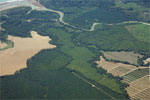
|
|
(03/16/2009) The global economic crisis has slowed demand for timber products and may undermine efforts to improve the environmental performance of forestry, reports the U.N. Food and Agriculture Organization (FAO) in its biannual "State of the World's Forests 2009", released today.
[Forests | Forestry | Logging]
Experts forecast probability of global warming tipping points
(03/16/2009) The probability of Earth's climate passing a "tipping point" that could result in large impacts within the next two centuries is greater than 50 percent, according to research published in Proceedings of the National Academy of Sciences
[Climate change]
Tuna industry launches new organization to save tuna from themselves
(03/16/2009) Yesterday saw the launch of the International Seafood Sustainability Foundation (ISSF). Composed of scientists, environmental organizations, and the tuna industry, ISSF will focus on ensuring that tuna populations are preserved from overfishing.
[Fish]
Dams in Laos threaten Asia's largest waterfall, critically endangered river dolphin
(03/16/2009) Eleven proposed hydroelectric projects on the Mekong River in Southeast Asia threaten migratory fish stocks, regional food security, and the livelihoods of millions of people, warns a new campaign launched by environmental groups.
[Dams | Laos]
Shortsighted recommendations to eat more fish ignore large-scale environmental impact
(03/16/2009) Recommendations by international health agencies, doctors, nutritionists, and the media to consume more fish for better health ignore the fact that fish stock are collapsing worldwide, reports a new study published in the Canadian Medical Association Journal. “Even at current levels of fish consumption, fisheries globally have reached a state of severe crisis. Already, the demand from affluent and developing economies, particularly newly affluent China, cannot be met by the world’s fisheries,” states the new report.
[Fish]
Rise in sea levels due to global warming could imperil New York City
(03/16/2009) A new study shows that sea levels along the United States' northeastern coast will rise nearly twice as fast during this century than previous predictions. By 2100 the waters around New York city could rise as much as 18 inches, leaving Manhattan particularly vulnerable to flooding from hurricanes and winter storm surges.
[Sea levels]
Fastest evolving bird family produces new species
(03/16/2009) Discovered in the Solomon Island of Vanikoro, a new species of bird from the white-eye family leads credence to the belief that white-eyes are the world's fastest evolving family of birds.
[Birds]
85% of the Amazon rainforest may be lost due to global warming
(03/14/2009) Warming climate could decimate up to 85 percent of the Amazon rainforest by 2150, according to a new computer model.
[Amazon | Rainforests]
Shells thinning due to ocean acidification
(03/13/2009) By soaking up excess CO2 from the atmosphere oceans are undergoing a rise in acidity which is having ramifications across their ecosystems, most frequently highlighted in the plight of coral reefs around the world. However, a new study in Nature Geoscience shows that the acidification is affecting another type of marine life. Foraminifera, a tiny amoeba-like entity numbering in the billions, have experienced a 30 to 35 percent drop in their shell-weight due to the high acidity of the oceans.
[Oceans | Ocean acidification]
New greenhouse gas ‘4,800 times more potent’ than carbon
(03/12/2009) Scientists from MIT and Scripps Institution of Oceanography have announced the discovery of an exceptionally potent new greenhouse gas. Sulfuryl fluoride is an up-and-coming fumigant against insects, but scientists have discovered that if the new gas becomes widely used it could contribute significantly to climate change.
[Greenhouse gases]
More Americans than ever believe global warming is ‘exaggerated’ by media
(03/12/2009) While a majority of Americans believe the media is either correct or underestimating the threat of climate change, more than ever believe the threat is exaggerated.
[Climate change]
Historic US law now extends to illegal logging
(03/11/2009) Enacted in 1900 by William F. McKinley the Lacey Act is the oldest wildlife protection law in the US; for a over a century it has protected animals from being illegally hunted and trafficked. An amendment made last year has now extended the law to protect plants for the first time, making it possible for the US to support efforts abroad and at home to combat illegal logging.
[Illegal logging | Environmental law]
Elephants populations in the Congo drop 80 percent in fifty years
(03/11/2009) According to the conservation organization Wildlife Direct ( Wildlife Direct) a recent survey of elephants in the Democratic Republic of Congo reveals that populations have dropped 80 percent in fifty years. The survey was conducted by John Hart using forest inventories, aerial surveys, and interview with local peoples.
[Elephants]
Dedicated rock-throwing chimp proves longterm planning
(03/10/2009) Biologists have suspected for a long time that animals other than humans are capable of making plans for future events, but it has proven difficult to show conclusively. However, a new study in Current Biology claims the first unambiguous evidence of an animal premeditating. Mathias Osvath of Lund University in Sweden has spent a decade observing a male chimpanzee in a zoo collecting stones, making them into concrete discs, and then throwing them at zoo visitors.
[Animal behavior | Primates]
Poison frog diversity linked to the Andes
(03/10/2009) Electric colors, wild markings, and toxic skin have made poison frogs well-known inhabitants of the Amazon rainforest. With 353 recognized species, and probably more awaiting discovery, poison frogs are an incredibly diverse group of amphibians. While it has long been believed that the Amazon basin, itself, was the source of their diversity, a new study published in PLoS Biology has uncovered that the Andes mountain chain has served as an oven of evolutionary biodiversity for poison frogs over several million years.
[Amphibians]
Seven new species of deep sea coral discovered
(03/09/2009) In the depths of the Papahānaumokuākea Marine National Monument, which surrounds ten Hawaiian islands, scientists discovered seven new species of bamboo coral. Supported by the National Ocean and Atmospheric Administration (NOAA), the discoveries are even more surprising in that six of the seven species may represent entirely new genus of coral.
[Oceans]
Rarest rhino caught on film wallowing in mud with calf
(03/06/2009) In a scene that appears out of an old jungle movie, The World Wildlife Fund (WWF) has caught the world’s rarest rhino on film. With less than 60 Javan rhinos estimated to exist in the wild, it is one of the world’s most imperiled species.
[Rhinos]
Infant blue whale filmed underwater
(03/06/2009) Off the waters of Costa Rica in January 2008 scientists and photographers with National Geographic filmed an infant blue whale swimming near its mother. They believe this is the first time a baby blue whale has been filmed underwater.
[Whales]
In exchange for marriage certificate Indonesians must donate trees
(03/05/2009) An Indonesian district in West Java, Garut, has started a unique program to support reforestation. As reported by Reuters, any couple planning to get married must give ten trees to local authorities for reforestation efforts before marriage will be legally sanctioned.
[Indonesia | Reforestation]
'Stopgap’ to preserve US bats from devastating fungus
(03/05/2009) Half a million bats have succumbed to a mysterious fungal disease known as white-nose syndrome in two years. Found in seven states in the northeastern US, this syndrome has left biologists baffled since first discovered in 2006. While researchers are still trying to uncover the relationship of the syndrome to the bats, a recent study published in Frontiers in Ecology and the Environment e-View suggests a way to mitigate the syndrome devastating affect. Employing a mathematical simulation the researchers found that using localized heat sources on hibernating bats may preserve populations while a long-term solution is found.
[Conservation | Endangered species | Wildlife]
When science hijacks conservation funding

|
|
(03/04/2009) A scientist's job is to create new knowledge. Thus it is not surprising that scientists are most interested in their own research. Scientists use many methods to raise funds to support their research agendas and build their reputations. Scientists collect information, publish their results, and seek out new opportunities. Because science is a tool that can be used for conservation, scientists often seek donations from conservation organizations to support their research projects.
[Conservation | Endangered species | Wildlife]
Clean energy investment moving too slow to avoid irreversible climate change
(03/04/2009) Stalled clean energy investment due to the current recession makes severe climate change more likely, according to a new report by analysts with New Energy Finance (NEF).
[Energy | Cleantech | Economics]
Only one out of 91 species of antelope is on the rise

|
|
(03/04/2009) The springbok is the only antelope species whose population is on the rise, according to a new review by the Red List for the International Union for Conservation of Nature (IUCN). In addition, over a quarter of the antelopes, 25 species out of 91, are considered threatened with extinction. “Unsustainable harvesting, whether for food or traditional medicine, and human encroachment on their habitat are the main threats facing antelopes,” says Dr Philippe Chardonnet, Co-Chair of the IUCN Antelope Specialist Group.
[Mammals | Endangered species | Wildlife]
Indonesia applies for REDD partnership to protect forests
(03/04/2009) Indonesia has applied to join the World Bank's Forest Carbon Partnership Facility, becoming the largest developing country to apply to a program that seeks to reduce greenhouse gas emissions by saving tropical forests, reports Reuters.
[Indonesia | REDD | Avoided deforestation]
Amazon deforestation drops 70% for Nov 2008-Jan 2009 period
(03/04/2009) Deforestation in the Brazilian Amazon fell to 291 square miles (754 square kilometers) in the November 2008-January 2009 window, a drop of 70 percent compared to the year earlier period when 976 sq mi (2,527 sq km), said Environment Minister Carlos Minc.
[Amazon | Brazil | Deforestation]
Madagascar site for kids now in Russian and French
(03/04/2009) Mongabay's Madagascar site for kids (on wildmadagascar.org) is now available in Russian (thanks to Natali) and French (thanks to Claire). There are also German, Ukrainian, and Spanish versions. Meanwhile the rainforest site for children is available in 28 languages.
[Mongabay sites for kids]
Climate change could devastate lizards in the tropics

|
|
(03/04/2009) With help from data collected thirty years ago, scientists have discovered that tropical lizards may be particularly sensitive to a warming world. Researchers found that lizards in the tropics are more sensitive to higher temperatures than their relatives in cooler, yet more variable climates. "The least heat-tolerant lizards in the world are found at the lowest latitudes, in the tropical forests. I find that amazing," said Raymond Huey, lead author of a paper appearing in the March 4 Proceedings of the Royal Society B.
[Herps | Reptiles | Extinction | Impact of climate change]
Papua New Guinea creates first nature reserve

|
|
(03/03/2009) Home to numerous endemic species and some of the Asia’s last intact tropical forests, Papua New Guinea has created its first national conservation area. Unique in structure, the park is owned by 35 surrounding indigenous villages which have agreed unanimously to prohibit hunting, logging, mining, and other development within the park. The villages have also created a community organization that will oversee management of the park. The 10,000 villagers found partners in Woodland Park Zoo in Seattle, Conservation International, and National Geographic. The conservation organizations spent twelve years working with locals and the Papua New Guinea government to establish the YUS Conservation Area.
[Papua New Guinea | Happy-upbeat environmental | Rainforests]
Aquatic animals emit powerful greenhouse gas
(03/02/2009)
A number of water-dwelling species emit the greenhouse gas nitrous oxide, researchers announced today in the journal Proceedings of the National Academy of Sciences . Although nitrous oxide is low in concentration globally, it is considered the fourth largest contributor to climate change. This is due to its potency: in a hundred year period nitrous oxide by weight packs 310 times more punch as a greenhouse gas than carbon dioxide.
[Oceans | Greenhouse gases]
Time to give up on Tasmanian tiger, says DNA expert
(03/02/2009) Money and energy spent on finding the Tasmanian tiger should be used for other conservation purposes, according to Dr. Jeremy Austin from the University of Adelaide’s Centre for Ancient DNA. The Tasmanian tiger, or Thylacine, has captured the imagination of cryptozoologists ever since the last known individual died in the 1936 in the Hobart Zoo, which closed the next year. There have been several unreported sightings throughout the island since the 1930s, including inconclusive photos taken by German tourists.
[Extinction | Australia | Wildlife]
Largest US protest on climate change today
(03/02/2009)
At 1 PM EST activists from across the US plan to engage in civil disobedience at Capitol Power Plant in Washington DC. Organizers from 90 different groups estimate that more than 2,500 people will be joining in the protests making it the largest US protest on climate change to date. Owned by congress, Capital Power Plant is seen by activists as a longtime symbol of the US government’s consistent support for the use of coal, the leading source of CO2 emissions in the US.
[Activism | United States | Coal]
Most popular news articles for February
(03/01/2009)
News articles about the Amazon dominated for the month of February.
[Most popular]


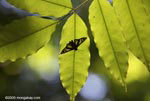




_100.jpg)






